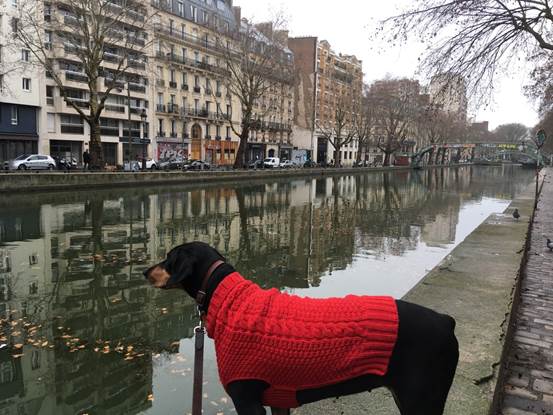Last week at our Live And Invest In Spain Conference I gave a presentation on bringing your pets overseas with you. It’s a somewhat recent addition to our conference presentation lineup, but it gets a full room and lots of questions every year, and I think it’s quickly becoming a must-include part of the moving overseas program that we put on for these events.
As one attendee wrote on their evaluation form, “Thank you for covering pets, it’s so important—they are family, too!”
When it comes to moving to Europe, pets couldn’t be more welcome.
This part of the world is super dog-friendly…
• Restaurants and shops are welcoming to dogs.
• Dogs are allowed on public transport in most countries.
• Many beaches are dog-friendly (and rules are rarely enforced if not); dog access to beaches is sometimes seasonal, meaning they can join you outside of summer months.
• Pet-friendly rental laws make it impossible for landlords to refuse pet households in many countries.
• Pet-friendly hotels are common.
• Off-leash walking is common.
If, like me, your life overseas wouldn’t be complete without your four-legged family members, don’t worry. Although it adds some extra paperwork, and, frankly, yes, a good amount of stress to the adventure—I guarantee it’s worth it.
To give a quick summary of the paperwork process, you’ll need to:
• Have a USDA- or CFIA-accredited fill out an International Health Certificate within 30 days of travel;
• Translate it into the language of the country you’re moving to;
• Have it endorsed by the USDA or CFIA within 10 days of travel;
• Have it authenticated at the nearest consulate of your destination country;
• And have it legalized or apostilled by the Secretary of State or Global Affairs Canada.
There are some more ins and outs to all this that you’ll need to be aware of when it actually comes to making the move (things like which order these need to be done depending on whether you’re coming from the States or Canada), but those are the broad strokes.
Start Your New Life Today, Overseas
But that’s only the paperwork, you’ll also need to prepare your pet in some other ways…
• Buy the airline ticket—but before you do, do some research on your airline. Pay attention to reputations and look carefully at their regulations and
restrictions to find the best airline for animal importation. Keep in mind that not all animals are permitted to fly (snub-nosed breeds). If you carry them on, take into account that they will count as a piece of carry-on luggage, reducing your bag count.
• Buy an airline-approved crate for cabin or cargo (dimensions and materials are very specifically regulated, you can’t necessarily just use the carrier you already have).
• Get your pet used to the carrier in advance, don’t just throw them in it the day of travel. My Doberman required a massive crate for cargo that split open in the middle, so we put her bed in the bottom half and let her live in it for a few months before adding the roof a couple weeks before travel. By the time it came to flying, she already considered it her safe space.
• Pack the crate with their bed, toys, and some unwashed clothing or a towel that smells like you.
• They’ll need to be up to date on their vaccinations, parasite treatments, and have a 15-digit, ISO-11784/5-compliant microchip.
A few other considerations…
• You can only travel with one, possibly two, animals per person, per the airline’s rules.
• You need to confirm that your flight arrives during business hours or that the correct customs officials (and possibly on-site vets) will be sure to be there
when you arrive.
• Animals can’t depart or arrive in extreme weather conditions (very high or low temperatures, for example), so seasons may be a limitation.
• Some countries require quarantine (e.g., Ireland).
• Some countries only allow animals to enter through certain airports (e.g., Spain).
• Most countries have lists of restricted/banned breeds (some are completely banned, e.g., France; some require extra paperwork or registration e.g., Spain and Portugal).
• There may be regional limitations (e.g., Tenerife Island in Spain requires 24 hours’ notice before an animal’s arrival; Rome and Sweden both have stringent animal welfare laws that may come as a shock).
Start Your New Life Today, Overseas
All that said and done, there’s a wonderful upside to having pets in your new home, whether you bring them with you or adopt in your new home. When moving overseas, one of the hardest things to do—after you’ve gotten your residency and set up your home and generally gotten settled—is integrating into your new neighborhood.
This can be especially true in Europe, where people tend to be less outgoing. Americans are extremely warm and welcoming compared to most other cultures—we like to chat and we make acquaintances, even friends, quickly and easily.
Southern Europe—Italy, Portugal, Spain, Greece—is a different story. In these more easygoing countries, people are often more quick to make friends, but in the northern countries, it can be quite hard to break into the local social scene.
How Do You Go About Starting To Feel Like You Belong?
There are plenty of ways, of course, but one of the easiest for me has been through my dog.
When you have a dog, you’ve got no choice but to walk around your new home several times a day, so it’s an easy way to get your bearings and explore all the little streets around you.
Plus, generally speaking, people tend to like dogs. They stop to pet, ask about the breed, the age, the name… kids come up and ask to play… store owners and restauranteurs recognize you because someone with a dog is more memorable than one without. It’s a great way to force yourself into speaking the new language and practicing small talk every day.
Then you have to find a new vet, take the dog for some exploratory visits to choose which you prefer, register them in your new home (throughout the EU you’ll need to apply for a pet passport when you arrive), make your grooming appointments, ask them to send you anti-parasite reminders, etc.
That means you have to make some phone calls, stop into some offices, learn the pet-related vocabulary you’ll need to use—all the while introducing yourself and your four-legged family to the neighborhood.
As you start to recognize other pet owners who live nearby, you’ll come to know one another and after a few months, you’ll give each other a friendly nod and smile as you pass on the street. When you see each other in the park, you stop to have a chat.
Keep your eyes peeled for groups of dogs in parks, because these groups are likely to meet at certain times of day.
Depending on where you move, you may find dedicated dog parks, which are a great way to meet the other owners, but even informal meet ups allow you to insert yourself into your new community. You’ll be amazed at how much you’ll pick up by taking part—from language to tips on where to eat or which emergency plumber to call on a weekend and everything in between. Ask for people’s numbers and you’re likely to be added to dog walking group chats of local dog owners.
Start Your New Life Today, Overseas
How My Dog Helped Me With My Move Overseas
When we first moved to Paris, we lived in the 11th arrondissement, right off of the Canal St. Martin. Part of the canal is covered, and that area was made into a long park with gazebos, ping pong tables, playgrounds, and fitness areas. I would take my dog, Bella, there, safely fenced in as it was, and throw a stick for her. The park was home to countless “SDFs,” sans-domicile-fixe—the term for the homeless here in France. Many of these young men were refugees, most had jobs, albeit irregular (like food delivery), and they were friendly for the most part.

As time went on, I began to chat with those I saw regularly. One in particular became a bit of a pal. Rodrigo was from Guadeloupe, and as I had just moved from Panama, we bonded talking about coming from the Caribbean region to Paris. He loved my dog, Bella, and always made a point of saying hi when he saw me.
One day, just after giving birth to my daughter, I lost Bella. It’s my eternal shame, and I’ll never forgive myself… I can only offer myself the excuse of being a new mother and having few brain cells to use during those months. She was gone overnight and after calling every institution and visiting every vets’ office within a kilometer and learning nothing, I wondered if I’d ever see her again.
As I was coming back home from plastering the neighborhood in posters, I saw Rodrigo and told him the story. I asked him to keep an eye out for her and just an hour or so later, he called me to say he had seen her. Another SDF had found her the night before. He’d bought her premium food and slept with her under a bridge, sharing his blanket with her. He was on his way back to where he found her, hoping to find someone who knew her.
Over the following weeks, despite trying to remove the posters I had hung all over, people had recognized her from the photo. Neighbors, shopkeepers, restauranteurs, SDFs, and more stopped me to ask about her. I thanked all my lucky stars that I had these acquaintances in the neighborhood who knew her and were looking out for her.
And I realized that they all knew me to some degree through her. I was recognizable as a fixture in my quartier—it was a wonderful epiphany. I had come to belong there, even in the eyes of locals.
We’ve since moved, but near our old apartment were some old fenced in spaces that had been turned into unofficial dog parks. Every visit was somewhat terrifying—small talk in French makes me unspeakably nervous—but I forced myself to ask questions about other dogs and tried my best to answer those asked of me. Having the dogs as the point of conversation focus helped a lot.
In our new neighborhood, I haven’t found any dog parks, but a group of owners meets every morning on the Champs de Mars, and I’ve been pulled into the group by another American expat, the only other English-speaker in the group.
On Saturday mornings at the Jardin des Tuileries, where I do a bootcamp class, dozens of dog owners meet to let the pups run around with one another in the bosom of the Louvre—possibly the most gorgeous setting for a workout or dog park in the world. I’ve started bringing Bella to my workout and hanging out in the park with the other dogs after.
These little ways of increasing my interaction with the communities of Paris have been invaluable in boosting my confidence and making me feel like a real part of this new world.
Pets Need Time To Adjust Too
A final word on adaptability… we often talk about how hard it is for a foreigner to adapt to a new culture, but we rarely offer this same consideration to our beloved pets. Bella had a very hard time when we first moved. I even bought her some homeopathic supplements to reduce her anxiety.
Panama was a city, too, but Paris is much louder and busier than Panama at the street level. I had such beautiful fantasies of bringing her to cafés and walking her all over the city, but she absolutely hated Paris at first. She barely wanted to leave the house to pee. Partially, this was due to coming from the tropics to December in Europe—she had literally never felt the cold before, of course it was disorienting for her. But it was also the sounds and, I assume, the smells.
I don’t know when exactly she came around, but over time, step by step, she got used to it. She now loves life again. She was used to being off-leash in Panama, but when we first got here, there wasn’t a chance of it. It was as if she had lost control of herself and couldn’t hear or feel me when we were out of the house. She was in full panic mode. Now, once again, I rarely put her on a leash; she happily trots around as we walk in our neighborhood, stops when I tell her, and never strays.
So if you’re moving from one environment to another—be it from small town to city, or city to rural life… from warm weather to cold, etc.—be prepared for your dog to need their own adjustment period.
But once they’ve adapted, put them to work for you and get out to explore your new home together—it’s all the more fun to do it with a buddy.
Bonne route,

Kat Kalashian
Editor, In Focus: Europe










